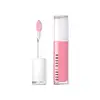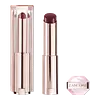Bobbi Brown Extra Plump Lip Serum Versus Lancôme Lip Idôle Squalane-12 Butterglow Hydrating Lip Balm
What's inside
What's inside
 Key Ingredients
Key Ingredients

 Benefits
Benefits

 Concerns
Concerns

 Ingredients Side-by-side
Ingredients Side-by-side

Hydrogenated Polyisobutene
EmollientOctyldodecanol
EmollientDextrin Palmitate
EmulsifyingLimnanthes Alba Seed Oil
Skin ConditioningDiisostearyl Malate
EmollientIsocetyl Alcohol
EmollientTheobroma Cacao Seed Butter
EmollientTriisostearyl Citrate
EmollientCaprylic/Capric Triglyceride
MaskingButyrospermum Parkii Butter
Skin ConditioningEthylene/Propylene/Styrene Copolymer
Pentaerythrityl Tetraisostearate
EmollientSodium Hyaluronate
HumectantPhoenix Dactylifera Fruit Extract
EmollientSalicornia Herbacea Extract
Skin ConditioningButyrospermum Parkii Butter Unsaponifiables
Skin ConditioningCitrus Grandis Peel Oil
MaskingRicinus Communis Seed Oil
MaskingOlea Europaea Fruit Oil
MaskingPersea Gratissima Oil
Skin ConditioningSimmondsia Chinensis Seed Oil
EmollientCamellia Japonica Seed Oil
EmollientHydrogenated Castor Oil
EmollientBrassica Campestris Sterols
EmollientCholesterol
EmollientCeramide Ng
Skin ConditioningTocopheryl Acetate
AntioxidantTocopherol
AntioxidantLactic Acid
BufferingPalmitoyl Tripeptide-1
Skin ConditioningPalmitoyl Tetrapeptide-7
Skin ConditioningC18-36 Acid Triglyceride
EmollientC18-36 Acid Glycol Ester
EmollientPhytosteryl/Octyldodecyl Lauroyl Glutamate
Skin ConditioningTribehenin
EmollientPhytosterols
Skin ConditioningEthylhexyl Palmitate
EmollientPolybutene
C12-15 Alkyl Benzoate
AntimicrobialPolyglyceryl-6 Polyricinoleate
EmulsifyingAcetyl Glucosamine
Skin ConditioningCaprylyl Glycol
EmollientCopernicia Cerifera Wax
Silica
AbrasiveButylene/Ethylene/Styrene Copolymer
Sorbitan Isostearate
EmulsifyingSorbitan Laurate
EmulsifyingSorbitan Oleate
EmulsifyingLimonene
PerfumingAscorbyl Palmitate
AntioxidantBHT
AntioxidantMica
Cosmetic ColorantCI 77891
Cosmetic ColorantCI 77491
Cosmetic ColorantCI 77492
Cosmetic ColorantCI 77499
Cosmetic ColorantCI 77163
Cosmetic ColorantCI 42090
Cosmetic ColorantCI 77400
Cosmetic ColorantCI 75470
Cosmetic ColorantCI 77742
Cosmetic ColorantCI 45370
Cosmetic ColorantCI 15850
Cosmetic ColorantCI 45380
Cosmetic ColorantCI 45410
Cosmetic ColorantCI 73360
Cosmetic ColorantCI 17200
Cosmetic ColorantCI 19140
Cosmetic ColorantCI 15985
Cosmetic ColorantHydrogenated Polyisobutene, Octyldodecanol, Dextrin Palmitate, Limnanthes Alba Seed Oil, Diisostearyl Malate, Isocetyl Alcohol, Theobroma Cacao Seed Butter, Triisostearyl Citrate, Caprylic/Capric Triglyceride, Butyrospermum Parkii Butter, Ethylene/Propylene/Styrene Copolymer, Pentaerythrityl Tetraisostearate, Sodium Hyaluronate, Phoenix Dactylifera Fruit Extract, Salicornia Herbacea Extract, Butyrospermum Parkii Butter Unsaponifiables, Citrus Grandis Peel Oil, Ricinus Communis Seed Oil, Olea Europaea Fruit Oil, Persea Gratissima Oil, Simmondsia Chinensis Seed Oil, Camellia Japonica Seed Oil, Hydrogenated Castor Oil, Brassica Campestris Sterols, Cholesterol, Ceramide Ng, Tocopheryl Acetate, Tocopherol, Lactic Acid, Palmitoyl Tripeptide-1, Palmitoyl Tetrapeptide-7, C18-36 Acid Triglyceride, C18-36 Acid Glycol Ester, Phytosteryl/Octyldodecyl Lauroyl Glutamate, Tribehenin, Phytosterols, Ethylhexyl Palmitate, Polybutene, C12-15 Alkyl Benzoate, Polyglyceryl-6 Polyricinoleate, Acetyl Glucosamine, Caprylyl Glycol, Copernicia Cerifera Wax, Silica, Butylene/Ethylene/Styrene Copolymer, Sorbitan Isostearate, Sorbitan Laurate, Sorbitan Oleate, Limonene, Ascorbyl Palmitate, BHT, Mica, CI 77891, CI 77491, CI 77492, CI 77499, CI 77163, CI 42090, CI 77400, CI 75470, CI 77742, CI 45370, CI 15850, CI 45380, CI 45410, CI 73360, CI 17200, CI 19140, CI 15985
Polyglyceryl-2 Triisostearate
EmulsifyingSqualane
EmollientBis-Behenyl/Isostearyl/Phytosteryl Dimer Dilinoleyl Dimer Dilinoleate
EmollientButyrospermum Parkii Butter
Skin ConditioningCellulose
AbsorbentDimer Dilinoleyl Dimer Dilinoleate
EmollientPolyglyceryl-3 Beeswax
EmulsifyingHelianthus Annuus Seed Cera
EmollientHydrogenated Castor Oil Dimer Dilinoleate
Skin ConditioningSimmondsia Chinensis Butter
Skin ConditioningHydrogenated Jojoba Oil
AbrasiveCandelilla Cera
EmollientRosa Centifolia Extract
Skin ConditioningCamelina Sativa Seed Oil
Skin ConditioningCanola Oil
EmollientMentha Piperita Oil
MaskingCeramide NP
Skin ConditioningSaccharomyces Ferment Filtrate
HumectantSilica
AbrasiveAluminum Hydroxide
EmollientPropylene Glycol
HumectantCitric Acid
BufferingTocopherol
AntioxidantPentaerythrityl Tetra-Di-T-Butyl Hydroxyhydrocinnamate
AntioxidantCI 45380
Cosmetic ColorantCI 45410
Cosmetic ColorantCI 15850
Cosmetic ColorantCI 77891
Cosmetic ColorantCI 19140
Cosmetic ColorantLimonene
PerfumingBenzyl Benzoate
AntimicrobialParfum
MaskingPolyglyceryl-2 Triisostearate, Squalane, Bis-Behenyl/Isostearyl/Phytosteryl Dimer Dilinoleyl Dimer Dilinoleate, Butyrospermum Parkii Butter, Cellulose, Dimer Dilinoleyl Dimer Dilinoleate, Polyglyceryl-3 Beeswax, Helianthus Annuus Seed Cera, Hydrogenated Castor Oil Dimer Dilinoleate, Simmondsia Chinensis Butter, Hydrogenated Jojoba Oil, Candelilla Cera, Rosa Centifolia Extract, Camelina Sativa Seed Oil, Canola Oil, Mentha Piperita Oil, Ceramide NP, Saccharomyces Ferment Filtrate, Silica, Aluminum Hydroxide, Propylene Glycol, Citric Acid, Tocopherol, Pentaerythrityl Tetra-Di-T-Butyl Hydroxyhydrocinnamate, CI 45380, CI 45410, CI 15850, CI 77891, CI 19140, Limonene, Benzyl Benzoate, Parfum
 Reviews
Reviews

Ingredients Explained
These ingredients are found in both products.
Ingredients higher up in an ingredient list are typically present in a larger amount.
This ingredient is also known as shea butter. It is an effective skin hydrator and emollient.
Emollients help soothe and soften your skin. It does this by creating a protective film on your skin. This barrier helps trap moisture and keeps your skin hydrated. Emollients may be effective at treating dry or itchy skin.
Shea butter is rich in antioxidants. Antioxidants help fight free-radicals, or molecules that may harm the body. It is also full of fatty acids including stearic acid and linoleic acid. These acids help replenish the skin and keep skin moisturized.
While Shea Butter has an SPF rating of about 3-4, it is not a sunscreen replacement.
Shea butter may not be fungal acne safe. We recommend speaking with a professional if you have any concerns.
Learn more about Butyrospermum Parkii ButterCi 15850 is the pigment color red. It is an azo dye and created synthetically.
Azo dyes need to be thoroughly purified before use. This allows them to be more stable and longer-lasting.
This ingredient is common in foundations, lipsticks, and blushes. This color is described as brown/orangey red.
It has many secondary names such as Red 6 and Red 7. According to a manufacturer, Red 6 usually contains aluminum.
Learn more about CI 15850CI 19140 is also known as Tartrazine. Tartrazine is a synthetic dye used in cosmetics, foods, and medicine to add a yellow color.
Tartrazine is created from petroleum and is water-soluble.
Some people may experience allergies from this dye, especially asthmatics and those with an aspirin intolerance.
Learn more about CI 19140Ci 45380 is a synthetic dye that comes from coal or tar sources. Due to this, it is often used in small quantities.
A common name for this dye is Red 22. Red 22 imparts a warm reddish color.
Similar to Red 27, this dye changes color based on pH and moisture levels.
This dye is colorless when dry but turns pink between pH levels 0.0 to ~3.0.
Learn more about CI 45380CI 45410 is a synthetic red-pigment and dye.
It often goes by both Red 28 or Red 27; manufacturers label both ingredients as CI 45410.
This dye is commonly found in makeup because it imparts a vivid color. Some types of this dye change color based on pH level and interaction with moisture:
Your skin has a natural pH of around 4.5 - 5.5.
According to the FDA, CI 45410 is not permitted for use in eye products.
Red 27 is a flourescein dye and commonly used as a fluorescent tracer in medicine.
Learn more about CI 45410Ci 77891 is a white pigment from Titanium dioxide. It is naturally found in minerals such as rutile and ilmenite.
It's main function is to add a white color to cosmetics. It can also be mixed with other colors to create different shades.
Ci 77891 is commonly found in sunscreens due to its ability to block UV rays.
Learn more about CI 77891Limonene is a fragrance that adds scent and taste to a formulation.
It's found in the peel oil of citrus fruits and other plants such as lavender and eucalyptus. The scent of limonene is generally described as "sweet citrus".
Limonene acts as an antioxidant, meaning it helps neutralize free radicals.
When exposed to air, oxidized limonene may sensitize the skin. Because of this, limonene is often avoided by people with sensitive skin.
The term 'fragrance' is not regulated in many countries. In many cases, it is up to the brand to define this term. For instance, many brands choose to label themselves as "fragrance-free" because they are not using synthetic fragrances. However, their products may still contain ingredients such as essential oils that are considered a fragrance.
Learn more about LimoneneSilica, also known as silicon dioxide, is a naturally occurring mineral. It is used as a fine, spherical, and porous powder in cosmetics.
Though it has exfoliant properties, the function of silica varies depending on the product.
The unique structure of silica enhances the spreadability and adds smoothness, making it a great texture enhancer.
It is also used as an active carrier, emulsifier, and mattifier due to its ability to absorb excess oil.
In some products, tiny microneedles called spicules are made from silica or hydrolyzed sponge. When you rub them in, they lightly polish away dead skin layers and enhance the penetration of active ingredients.
Learn more about SilicaTocopherol (also known as Vitamin E) is a common antioxidant used to help protect the skin from free-radicals and strengthen the skin barrier. It's also fat soluble - this means our skin is great at absorbing it.
Vitamin E also helps keep your natural skin lipids healthy. Your lipid skin barrier naturally consists of lipids, ceramides, and fatty acids. Vitamin E offers extra protection for your skin’s lipid barrier, keeping your skin healthy and nourished.
Another benefit is a bit of UV protection. Vitamin E helps reduce the damage caused by UVB rays. (It should not replace your sunscreen). Combining it with Vitamin C can decrease sunburned cells and hyperpigmentation after UV exposure.
You might have noticed Vitamin E + C often paired together. This is because it is great at stabilizing Vitamin C. Using the two together helps increase the effectiveness of both ingredients.
There are often claims that Vitamin E can reduce/prevent scarring, but these claims haven't been confirmed by scientific research.
Learn more about Tocopherol